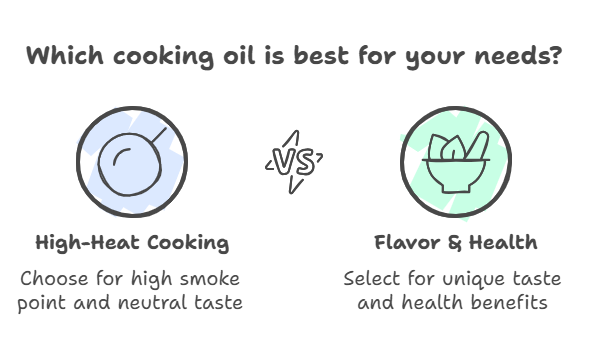You’ve probably seen coconut oil for cooking everywhere lately. It seemed to pop up in kitchens and health food stores almost overnight. People talk a lot about using coconut oil for cooking, but there’s also plenty of confusion around it.
“Coconut oil is a versatile and healthy cooking oil, but like all oils, moderation is key.”
Dr. Anna Williams
Is it really a healthy choice among cooking oils? Which type should you buy from the grocery store? Can you actually fry with it? Let’s clear up some of the myths and look at how coconut oil for cooking fits into your healthy eating routine.
What Exactly Is Coconut Oil for Cooking?
Coconut oil for cooking comes from, you guessed it, coconuts. Specifically, it’s extracted from the white flesh, called the kernel or meat, of mature coconuts. The method used for extraction significantly impacts the final product you find on the shelf.
There are two main methods: dry processing and wet processing. Dry processing involves drying the coconut meat first (creating “copra”) and then pressing the oil out, which often requires more refinement. Wet processing uses fresh coconut meat, pressing out coconut milk first, and then separating the oil, typically resulting in a less processed product.
This oil is predominantly fat, composed of about 90% saturated fat. This high saturated fat content is why it remains solid at cooler room temperature, unlike liquid vegetable oils such as olive oil or canola oil. The specific types of fatty acids within this fat are central to ongoing health discussions.
Understanding the Different Kinds of Coconut Oil
Walking down the oil aisle can be confusing with various coconut oils available. You’ll encounter labels like “refined,” “unrefined,” “virgin,” and “extra virgin,” often alongside options like organic coconut oil for cooking. Knowing the difference helps you choose the right coconut oil for your specific cooking needs and desired flavor profile.
Refined Coconut Oil
Refined coconut oil for cooking typically starts with dried coconut meat (copra). Because the drying process isn’t always perfectly clean, the extracted oil needs additional processing. It gets filtered, bleached using natural clays (not harsh chemical bleach), and deodorized with steam.
This thorough processing removes impurities and potential contaminants. It also strips away the distinct coconut flavor and aroma, yielding a neutral-tasting cooking fat. Importantly, refining increases its smoke point, generally placing it around 400 to 450 degrees Fahrenheit (204-232 Celsius).
This high smoke point makes refined coconut oil a suitable choice for higher-heat cooking methods. Consider using it for sautéing, stir-frying, roasting vegetables, and even certain types of frying. Its neutrality won’t impart unwanted coconut flavor to savory dishes.
Unrefined (Virgin/Extra Virgin) Coconut Oil
Unrefined coconut oil, often labeled as virgin coconut oil for cooking or extra virgin, typically uses fresh coconut meat and the wet processing method. It undergoes significantly less processing compared to its refined counterpart. This minimal processing allows it to retain its characteristic natural coconut smell and taste.
You might see “virgin” or “extra virgin” on the label when browsing. Unlike olive oil, these terms don’t have strict, legally defined standards for coconut oil for cooking, as noted by Harvard’s School of Public Health1 research. They generally indicate that the oil is unrefined, minimally processed, and often comes from fresh organic coconut sources.
Because it is less processed, unrefined coconut oil possesses a lower smoke point. This temperature is typically around 350 degrees Fahrenheit (177 Celsius). It performs best in lower-temperature cooking, baking applications where a distinct coconut flavor is desired, or as a finishing oil added directly to food.
Liquid Coconut Oil
You might also spot liquid coconut oil for cooking on shelves at the grocery store. This variant remains liquid even when refrigerated or stored at cool room temperature. Manufacturers create this form by removing most of the lauric acid, a primary saturated fat in coconut oil known for solidifying easily.
Sometimes, producers add more medium-chain triglycerides (MCTs) back into the liquid form. While this offers convenience and is sometimes marketed for quick energy relevant to sports nutrition, the processing significantly alters its natural fatty acid profile compared to traditional coconut oils. Its cooking applications might differ, and it’s not a direct substitute in recipes relying on coconut oil’s solid state.
Organic Coconut Oil
Many brands offer organic coconut oil for cooking options, both refined and unrefined. Choosing certified organic coconut oil for cooking means the coconuts were grown without synthetic pesticides or fertilizers. This adheres to specific agricultural standards, which can be important for consumers prioritizing organic food intake.
Why Smoke Point Matters in Cooking
We’ve mentioned smoke point several times. Why is this temperature so critical when choosing cooking oils? The smoke point is the temperature at which an oil begins to break down, burn, and produce visible smoke.
When cooking oil exceeds its smoke point, it not only affects the flavor but also produces harmful compounds like free radicals and acrolein, which can be damaging over time. To minimize these risks, choosing an oil with a high smoke point for specific cooking methods is essential.
For more details on grapeseed oil, including its smoke point and uses, visit the full article here.
This is precisely why selecting the appropriate oil for your cooking temperature is essential for both taste and well-being. Refined coconut oil, boasting a higher smoke point, handles heat much better than the more delicate unrefined version. You certainly wouldn’t want to deep-fry using flavorful, low-smoke point unrefined coconut oil for cooking.
| Oil Type | Typical Smoke Point (°F) | Typical Smoke Point (°C) | Best Uses |
|---|---|---|---|
| Unrefined (Virgin) Coconut Oil | ~350°F | ~177°C | Low-heat baking, light sautéing, adding flavor, smoothies. |
| Refined Coconut Oil for cooking | 400-450°F | 204-232°C | Sautéing, stir-frying, roasting, baking, general cooking fat. |
| Extra Virgin Olive Oil | 325-375°F | 163-191°C | Salad dressings, finishing, low-heat sautéing, dipping bread. |
| Avocado Oil (Refined) | ~520°F | ~271°C | High-heat cooking, searing, frying, grilling. |
| Canola Oil (Refined) | ~400°F | ~204°C | General cooking, baking, frying, where neutral flavor is needed. |
| Butter | ~302°F | ~150°C | Low-heat baking, sautéing, spreading, flavor enrichment. |
Remember, these smoke points are general guidelines. Actual values can vary slightly based on the specific brand, processing methods, and age of the oil.
Practical Uses for Coconut Oil for Cooking
Okay, let’s get practical with popular cooking applications. How can you actually use these different types of coconut oil for cooking in your everyday meals? Its versatility shines when you match the right type to the right task.
High-Heat Cooking (Refined)
Refined coconut oil for cooking truly excels when the cooking temperature rises. Its neutral flavor profile ensures it won’t clash with the other ingredients in your dish. Use it confidently for sautéing vegetables until they are perfectly tender-crisp.
It functions well for stir-fries, providing a stable cooking fat that can withstand typical wok temperatures without smoking excessively2. You can also use it effectively for roasting potatoes, root vegetables, or even chicken in the oven at higher heat settings. Many find it a reliable cooking fat.
Because it lacks a strong coconut essence, it won’t make your savory dishes taste unexpectedly tropical. This neutrality makes refined coconut oil a flexible staple for a wide range of recipes, fitting seamlessly into diverse cuisines.
Baking (Refined or Unrefined)
Coconut oil for cooking has become a popular substitute for butter, lard, or shortening in many baking recipes. Since it’s solid at typical room temperature, it can help create desirable flaky textures in items like pie crusts and pastries. It performs similarly to other solid fats in cookies, cakes, and breads.
You have the choice between refined or unrefined coconut oil for cooking, depending on the desired flavor outcome. Refined oil maintains taste neutrality, allowing other flavors to dominate. Unrefined coconut oil, conversely, imparts a distinct coconut essence, which is perfect for recipes where that flavor complements other ingredients, such as in certain muffins, granola, or tropical-flavored desserts.
Remember to measure it accurately; sometimes recipes might suggest using slightly less coconut oil than butter due to fat content differences. Many vegan and plant-based baking recipes specifically call for coconut oil as a butter alternative. Websites dedicated to plant-based cooking, like Minimalist Baker3, frequently feature recipes utilizing it effectively.
Lower-Heat Applications (Unrefined)
Unrefined virgin coconut ofor cooking il brings its delightful tropical aroma and distinct taste to the forefront. Utilize it in situations where you want that characteristic flavor to enhance the dish. It’s fantastic for making stovetop popcorn, adding a subtle sweetness and richness.
You can employ it for a light sauté of delicate ingredients, such as shrimp or scallops, over medium-low heat to avoid damaging the oil. Consider melting it and drizzling it over roasted sweet potatoes, winter squash, or even oatmeal for added richness and flavor. It can make food feel good4.
Its lower smoke point necessitates careful temperature control; overheating will degrade its flavor and quality. Keep the heat gentle to preserve its delicate compounds and prevent burning. This makes it less suitable for high-temperature frying or searing.
No-Cook Uses
You don’t always need heat to incorporate coconut oil for cooking into your diet. Add a spoonful of unrefined virgin coconut oil to smoothies for extra healthy fats and a subtle tropical note; this is common in sports nutrition plans. It’s also a frequent binding agent in homemade energy balls, bars, or raw desserts.
You might try whisking melted virgin coconut oil into salad dressings or sauces for added richness. However, remember that it will solidify if chilled below its melting point (around 76°F or 24°C). This could alter the texture of your salad dressing if stored in the refrigerator.
Some people incorporate coconut oil for cooking or MCT oil into their coffee or tea, often called “bulletproof” style, primarily for perceived energy benefits or as part of a ketogenic diet, rather than for traditional culinary flavor.
The Health Debate: Is Coconut Oil Good For You?
This is where the discussion surrounding coconut oil often becomes most intense. Coconut oil has been lauded as a superfood by some proponents while facing criticism from various health organizations. The primary point of contention revolves around its exceptionally high saturated fat content.
Approximately 90% of the fat in coconut oil for cooking is saturated fat. Prominent health bodies like the American Heart Association (AHA)5 generally recommend limiting saturated fat intake significantly. They worry because studies show that saturated fats increase LDL (“bad”) cholesterol. High LDL is a known risk for heart disease and clogged arteries.
The AHA warns not to swap unsaturated vegetable oils, like olive or canola oil, for coconut oil. Studies show that eating coconut oil can raise LDL cholesterol more than unsaturated fats. The American Heart Association warns that overeating or frequent eating can harm heart health.
However, the story has more nuance because of coconut oil’s unique fatty acid profile. It has a lot of Medium-Chain Triglycerides (MCTs). Lauric acid makes up about 50%. It also contains caprylic and capric acids. Medium-chain fatty acids are processed differently by the body than Long-Chain Triglycerides (LCTs). LCTs are common in most dietary fats and oils.

The body processes MCTs differently. They go straight to the liver. There, they can be rapidly converted into energy or transformed into substances called ketones. MCT oil, often from coconut oil for cooking, converts energy quickly. This makes it popular in sports nutrition and ketogenic diets. Ketones from MCT oil serve as fuel for brain cells.
Some research suggests coconut oil and its components might offer certain oil benefits. Lauric acid has antimicrobial properties. It has been studied for its effects on some bacteria and fungi.
Studies on concentrated MCT oil (not whole coconut oil) suggest it may help with modest weight loss or better weight management. This might happen by increasing feelings of fullness or boosting energy use. However, results vary and depend on diet and calorie balance.
More research is needed to confirm if these findings apply directly to regular coconut oil consumption as part of a typical diet, particularly regarding efforts to lose weight.
There’s also debate about coconut oil’s effect on cholesterol levels beyond just LDL. Some studies say coconut oil for cooking may raise HDL (“good”) cholesterol. This might help balance the LDL increase a bit.
The overall impact on cardiovascular risk is still being debated. It relies on the type of oil used in studies and how individuals respond metabolically. The belief that saturated fats raise risk is too simple. We must also look at the type of saturated fat and the overall diet.
So, is coconut oil good or bad? The evidence is conflicting. The high saturated fat content raises valid concerns from years of heart health advice. However, we are still studying how its fatty acids, like lauric acid and MCTs, affect our health.
Most nutrition experts and health organizations recommend moderation. Using coconut oil for cooking sometimes for certain cooking tasks is different from using it as your main fat. A balanced diet should focus on whole foods and unsaturated fats.
Other uses contribute to its popularity but are separate from cooking. For instance, oil pulling, an ancient practice involving swishing oil in the mouth, sometimes uses coconut oil for cooking aiming to improve oral health, although robust clinical evidence is limited.
Similarly, some apply it topically for dry skin, believing it helps reduce water loss, but this isn’t related to its dietary effects. Claims related to drug-resistant epilepsy are generally linked to the ketogenic diet and concentrated MCT oil, not standard dietary coconut oil use.
How Does Coconut Oil Stack Up?
It’s helpful to compare coconut oil for cooking directly to other common cooking oils and fats. Each option presents unique properties, advantages, and disadvantages.
Refined coconut oil has a higher smoke point than extra virgin olive oil. This makes it better for high-heat cooking. Olive oil is praised for its high levels of monounsaturated fats and polyphenols. These compounds are closely tied to better heart health. Unrefined coconut oil for cooking has a lower smoke point than many olive oils. It also has a strong coconut flavor, which limits how you can use it.
Avocado oil is special because it has a high smoke point, especially the refined types. This makes it great for high-heat cooking like searing, frying, or grilling. It is also rich in beneficial monounsaturated fats, similar to olive oil. The main drawback can be its higher price point compared to coconut oil or canola oil.
Canola oil is easy to find and affordable. It has a neutral taste and a high smoke point, making it great for cooking and baking. It has both monounsaturated and polyunsaturated fats. This includes plant-based omega-3 fatty acids, known as ALA. Many canola oils are highly refined. This matters for people who want less processed foods.
Butter is a common cooking fat. It has a lower smoke point than refined coconut oil for cooking. However, it adds a unique flavor that many people love for baking and sautéing. It contains saturated fat but also some vitamins. Ghee, also known as clarified butter, has most milk solids taken out. This gives it a higher smoke point than regular butter.
Keeping different cooking oils and fats in your kitchen is a smart way to eat healthy. Use extra virgin olive oil for dressings, finishing dishes, and low-to-medium heat cooking.
Use refined coconut oil, avocado oil, or canola oil for high-heat cooking. Choose based on your taste and budget. Use unrefined coconut oil or butter for their unique flavors or the right texture in baking. This variety helps you get different fatty acids. You can pick the best oil for each cooking task.
Selecting and Storing Your Coconut Oil
Ready to purchase some coconut oil for cooking at the grocery store? Examine the label carefully before buying. It should clearly indicate if the product is refined or unrefined, often known as virgin or extra virgin. Choose based on your intended use: neutral flavor and higher heat tolerance (refined) or distinct coconut flavor for lower-heat cooking or specific baking needs (unrefined).
Choose certified organic options if you can. Organic coconut oil means certain farming practices were used.
The container, usually a glass jar or plastic tub, should be well-sealed and free from damage. Coconut oil changes between solid and liquid around 76°F (24°C). So, don’t worry if it looks different with the temperature; that’s normal.
Storing coconut oil correctly is straightforward. Keep it in a cool, dark place like a pantry or cupboard, away from direct sunlight and heat sources like the stove. Refrigeration isn’t necessary and will make it very hard, requiring warming before use.
Coconut oil for cooking has stable saturated fats, giving it a long shelf life. It can last up to two years or even longer with proper storage.
Always check the best-by or expiration date printed on the container. If the oil smells bad or sour, changes color a lot, or has mold, it is spoiled. You should throw it away.
Things to Keep in Mind
Coconut oil is great for cooking, but here are a few other things to think about. Coconut allergies are rare, but they can happen, unlike tree nut allergies. Individuals with sensitivities should exercise caution when introducing coconut oil into their diet.
Coconut oil, like all fats, is high in calories. It adds a lot of fat to meals. A single tablespoon contains roughly 120 calories and about 13-14 grams of fat, mostly saturated.
When tracking calories or fat for weight control or health, use coconut oil for cooking carefully. Treat it like butter, olive oil, or any other fat. Portion control is important for balanced food intake.
There’s also an environmental and ethical dimension to consider. These impacts differ by region and farming methods used.
If you care about sustainability and ethical sourcing, choose brands that have these values. Check for certifications like Fair Trade or see if they are open about their supply chain. Look at a company’s website for insights. But, always read their terms and privacy policy before sharing personal data.
Think about these factors and how coconut oil works in cooking. This will help you decide how to use coconut oil in your life. It helps reduce potential issues and allows you to feel good about your choices.
Conclusion
Coconut oil is useful for cooking, but knowing its traits is important.
Understanding the difference between refined and unrefined coconut oil is key for cooking. Refined coconut oil can handle high heat and has a neutral taste. Unrefined coconut oil has a strong coconut taste. This makes it great for low-heat cooking and specific baking recipes.
The health debate is complex. It mainly looks at high saturated fat content. It also explores the special benefits of medium-chain triglycerides (MCTs) and lauric acid.
Some studies show that oil might help with metabolism or fight germs. However, big health groups like the American Heart Association warn against it. They worry that too much saturated fat can harm cholesterol levels and heart health. Coconut oil for cooking good vs. bad isn’t a simple verdict.
Therefore, moderation appears to be the wisest approach. Using coconut oil for cooking now and then as one of many cooking fats is fine. Include lots of unsaturated fats, fruits, veggies, and whole grains in your diet.
Coconut oil can be a great tool, especially for vegan baking and high-heat cooking. It works well for these tasks. But, it shouldn’t replace healthy fats like olive oil in your daily diet.
Small Step, Big Impact
Next time you cook, try replacing your usual oil with coconut oil for a healthier option, and see how it affects both taste and your health.
Listen to this article
This is an AI generated Podcast version of the article.
- https://www.hsph.harvard.edu/nutritionsource/food-features/coconut-oil[↩]
- https://www.researchgate.net/publication/26664126_Understanding_oil_absorption_during_deep-fat_frying[↩]
- https://minimalistbaker.com[↩]
- https://www.sciencedirect.com/topics/food-science/lipids-in-food[↩]
- https://www.heart.org/en/healthy-living/healthy-eating/eat-smart/fats/saturated-fats[↩]



